Menu
Physics Lesson 4.6.2 - The Advantages of Drawing a Force Diagram When Dealing with Forces
Please provide a rating, it takes seconds and helps us to keep this resource free for all to use
Welcome to our Physics lesson on The Advantages of Drawing a Force Diagram When Dealing with Forces, this is the second lesson of our suite of physics lessons covering the topic of Newton's Second Law of Motion, you can find links to the other lessons within this tutorial and access additional physics learning resources below this lesson.
The Advantages of Drawing a Force Diagram When Dealing with Forces
When several forces are acting at an object (especially when forces are at different directions), it is better to start with drawing a force diagram. This helps us understand better the situation and estimate the possible direction of motion prior of making any calculation.
A force diagram includes all forces acting at an object despite some of them maybe are not involved in the motion process. The figure below shows a simple force diagram for an object moving at constant acceleration along a rough horizontal surface.
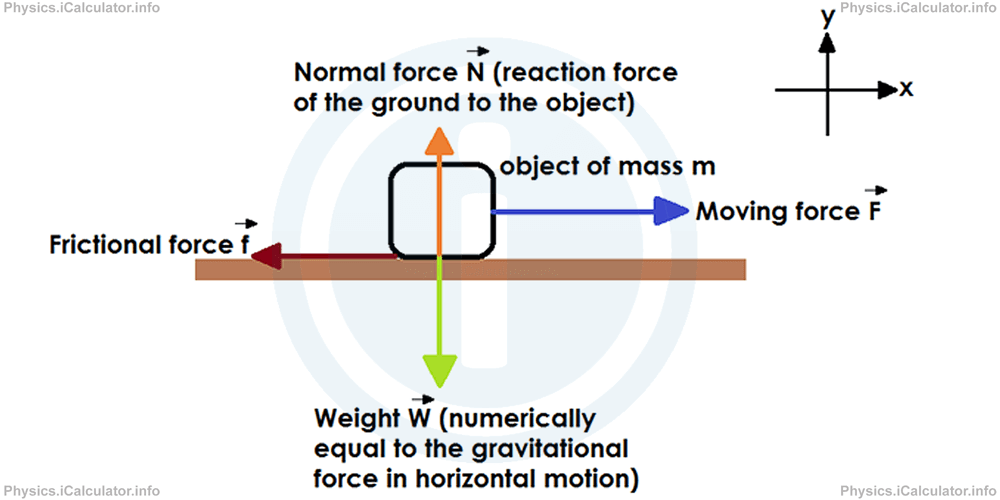
Weight and Normal Force are equal and opposite, and this fact is outlined through the equality in length of the vectors representing these forces. On the other hand, since the object is accelerating, the length of the moving force vector must be greater than that of frictional force vector and also their direction must be opposite because frictional force is a resistive force that acts in the opposite direction of motion (which in this example is due right).
If we use the standard notation for the directions of forces (x for the horizontal and y for the vertical), we have two horizontal forces (moving force F⃗ and frictional force f⃗) and two vertical (weight W⃗ and normal force N⃗) ones. We do not write the gravitational force F⃗g in this diagram as it is substituted by the weight.
When one or more forces do not lie only according one of the basic directions, we can use the components to represent them as shown in the figure below.
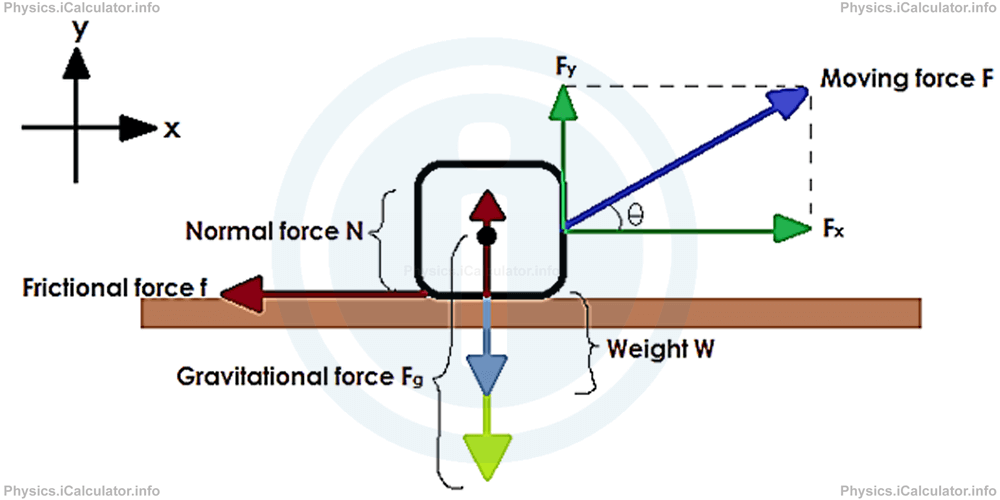
Since the acting force is neither completely horizontal, nor vertical, we split it into components. As a result, the weight (and normal force as well) will be smaller in magnitude than the gravitational force as its value is reduced because of the upward effect of the vertical component Fy of the moving force. The vector equation of weight is
= F⃗g - F⃗y
= m × g⃗ - |F⃗| × sin θ
This change also affects the value of frictional force f⃗ as
= μ × (m × g⃗ - |F⃗| × sin θ)
If the acting force in the figure above was sloped down, the object's weight would be greater than the gravitational force as the vertical component of the acting force Fy is directed downwards. As a result, the equation of weight W⃗ (as opposite to the normal force N⃗), is
= F⃗g + F⃗y
= m × g⃗ + |F⃗| × sin θ
Look at the figure:
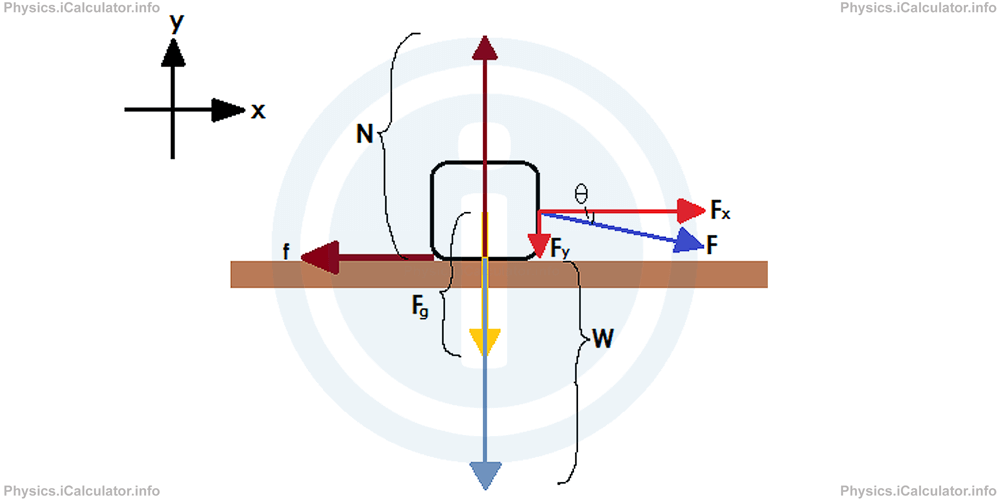
Example 2
:A 14 kg object is pulled along a horizontal plane by a 40N force, as shown in the figure below.
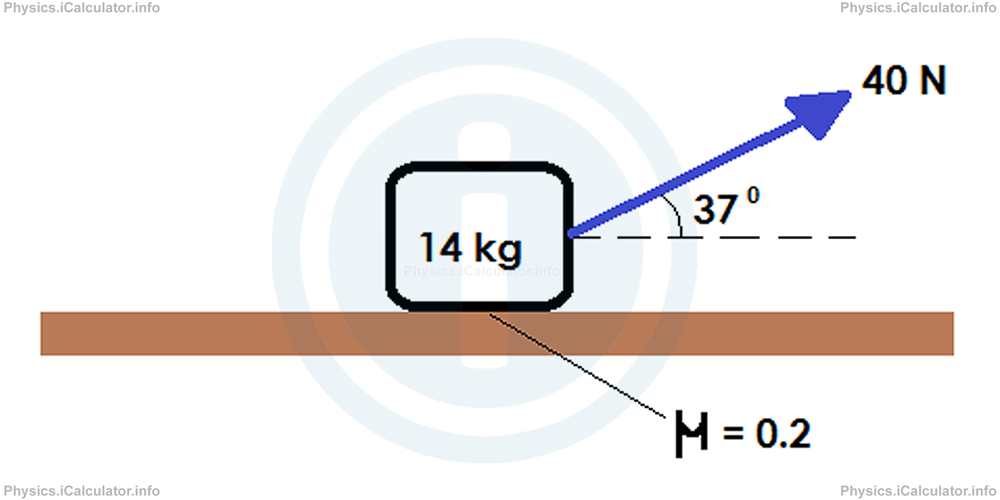
If the force acts at 37° sloped down direction, what is the displacement of the object in 20 s if it starts moving from rest? The friction coefficient between the object and the horizontal plane is 0.2. Take cos 37° = 0.8, sin 37° = 0.6 and g = 10 m/s2.
Solution 2
The first thing to do is to draw a force diagram as explained in the theory. The diagram is shown in the figure below.
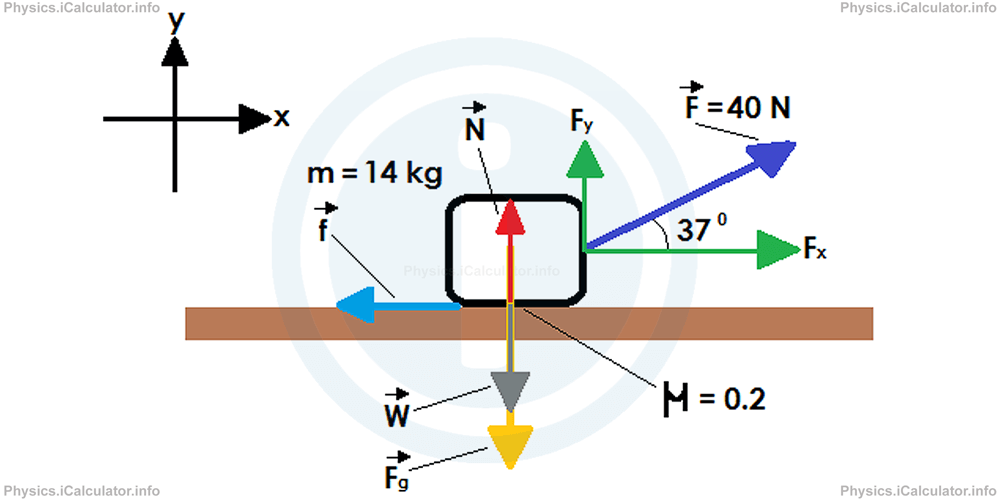
The Newton's Second Law of Motion for this case is
We have
and since the vertical component of the force F is directed upwards, we also have:
= μ × (m × g⃗ - |F⃗| × sin θ )
= 0.2 × (14 × 10 - 40 × 0.6)N
= 0.2 × (140N - 24N)
= 23.2N
Now we can substitute these values in the formula of Newton's Second Law of Motion to obtain the acceleration. We have
Therefore,
= 8.8N/14kg
= 0.63 m/s2
Now, let's use the kinematic formula
to find the displacement ∆x⃗, where the initial velocity v⃗0 = 0 as the object starts moving from rest. Hence, we obtain after substitutions,
=126 m
When the object lies on a slope, such as an inclined plane shown in the figure below, the reader has two possible choices:
- To split in components according the horizontal and vertical direction the Normal force, frictional force and any possible moving force (only gravitational force is vertical) and then making the calculations accordingly
- To rotate the axes in such a direction that one axis fits the plane (any possible motion occurs according this direction) and the other axis is perpendicular to the plane (it fits to the normal force). In this case, only gravitational force needs to split in directions. Look at the figure:
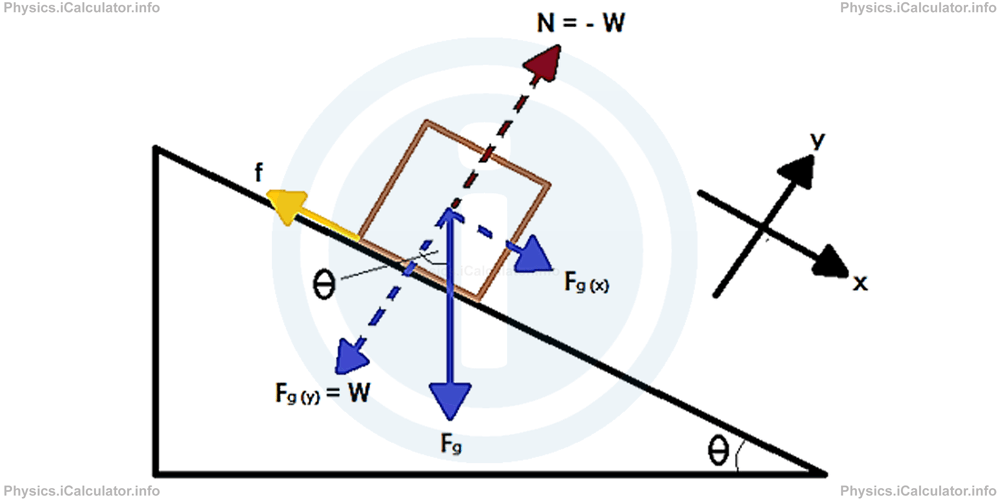
Even if no moving force is acting on the object, it tends to go downslope due to the x-component of the gravitational force Fg(x). Therefore, a frictional force f⃗ appears in the opposite direction of this moving tendency.
On the other hand, Weight is not equal to the Gravitational Force as they have different directions. However, Weight is equal to one of the Gravitational Force components, the y-component. As a result, the Normal Force will be numerically equal and in the opposite direction to this y-component of Fg as well.
Example 3
What is the acceleration of the object sliding downslope the plane shown in the figure above if the mass of the object is 4 kg, the plane is inclined at 25° to the horizontal direction? The friction coefficient between the object and the plane surface is 0.12. (Use the approximate values, cos 25° = 0.9, sin 25° = 0.4, g = 10 m/s2).
Solution 3
The first thing to do is drawing a force diagram where all forces including their components are shown when necessary. We have the diagram already drawn so there is no need to draw it again.
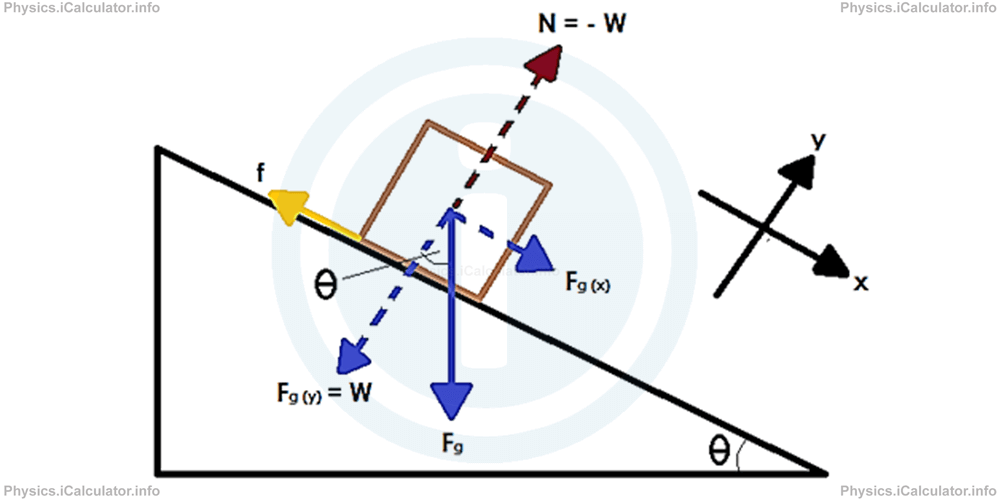
It is obvious that if there is any motion (and therefore any acceleration), it exists only in the downslope direction. Therefore, the Newton's Second Law of Motion (in scalar mode) for this direction (x-direction) is:
We have:
= m × g × sin θ
= 4 × 10 × 0.4
= 16 N
and
= μ × m × g × cos θ
= 0.12 × 4 × 10 × 0.9
= 4.32N
Therefore, we obtain after the substitutions
11.68 = 4 × a
Thus, the acceleration is
You have reached the end of Physics lesson 4.6.2 The Advantages of Drawing a Force Diagram When Dealing with Forces. There are 3 lessons in this physics tutorial covering Newton's Second Law of Motion, you can access all the lessons from this tutorial below.
More Newton's Second Law of Motion Lessons and Learning Resources
Whats next?
Enjoy the "The Advantages of Drawing a Force Diagram When Dealing with Forces" physics lesson? People who liked the "Newton's Second Law of Motion lesson found the following resources useful:
- Force Diagram Feedback. Helps other - Leave a rating for this force diagram (see below)
- Dynamics Physics tutorial: Newton's Second Law of Motion. Read the Newton's Second Law of Motion physics tutorial and build your physics knowledge of Dynamics
- Dynamics Revision Notes: Newton's Second Law of Motion. Print the notes so you can revise the key points covered in the physics tutorial for Newton's Second Law of Motion
- Dynamics Practice Questions: Newton's Second Law of Motion. Test and improve your knowledge of Newton's Second Law of Motion with example questins and answers
- Check your calculations for Dynamics questions with our excellent Dynamics calculators which contain full equations and calculations clearly displayed line by line. See the Dynamics Calculators by iCalculator™ below.
- Continuing learning dynamics - read our next physics tutorial: Newton's Third Law of Motion
Help others Learning Physics just like you
Please provide a rating, it takes seconds and helps us to keep this resource free for all to use
We hope you found this Physics lesson "Newton's Second Law of Motion" useful. If you did it would be great if you could spare the time to rate this physics lesson (simply click on the number of stars that match your assessment of this physics learning aide) and/or share on social media, this helps us identify popular tutorials and calculators and expand our free learning resources to support our users around the world have free access to expand their knowledge of physics and other disciplines.